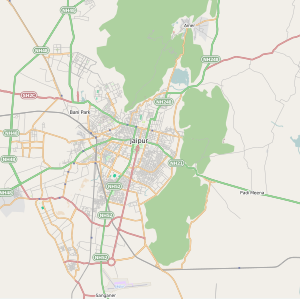
Amber or Amer, is a city near Jaipur in Jaipur district in the Indian state of Rajasthan. It is now a part of the Jaipur Municipal Corporation.

Jaipur is the capital and the largest city of the north-western Indian state of Rajasthan. As of 2011, the city has a population of 3.1 million, making it the tenth most populous city in the country. Located 268 km from the national capital New Delhi, Jaipur is also known as the Pink City due to the dominant color scheme of its buildings in old city.

Sawai Jai Singh II, was the 29th Kachwaha Rajput ruler of the Kingdom of Amber, who later founded the fortified city of Jaipur and made it his capital. He became the ruler of Amber at the age of 11, after the death of his father, Mirza Raja Bishan Singh, on 31 December 1699.

The Kachhwaha, or Kachhawa is a Rajput clan found primarily in India.
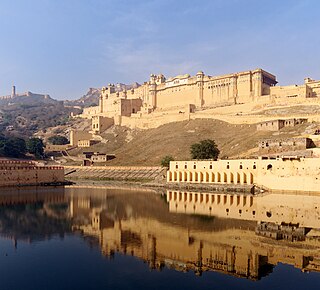
Amer Fort or Amber Fort is a fort located in Amer, Rajasthan, India. Amer is a town with an area of 4 square kilometres (1.5 sq mi) located 11 kilometres (6.8 mi) from Jaipur, the capital of Rajasthan. Located high on a hill, it is the principal tourist attraction in Jaipur. Amer Fort is known for its artistic style elements. With its large ramparts and series of gates and cobbled paths, the fort overlooks Maota Lake, which is the main source of water for the Amer Palace.

Sawai Madhopur is a city in the Sawai Madhopur district in the southeastern part of the Indian state of Rajasthan. It is the administrative headquarter of Sawai Madhopur District in Rajasthan.

Nahargarh Fort stands on the edge of the Aravalli Hills, overlooking the city of Jaipur in the Indian state of Rajasthan. Along with Amer Fort and Jaigarh Fort, Nahargarh once formed a strong defence ring for the city. The fort was originally named Sudershangarh, but it became known as Nahargarh, which means 'abode of tigers'. The popular belief is that Nahar here stands for Nahar Singh Bhomia, whose spirit haunted the place and obstructed construction of the fort. Nahar's spirit was pacified by building a temple in his memory within the fort, which thus became known by his name.

The Kingdom of Amber, also known as Kingdom of Dhundhar, and Jaipur State, was located in the north-eastern historic Dhundhar region of Rajputana and was ruled by the Kachwaha Rajput clan. It was established by Dulha Rai, possibly the last ruler of the Kachchhapaghata dynasty of Gwalior who migrated to Dausa and started his kingdom there with the support of Chahamanas of Shakambhari in the 12th century. Mostly through 12th to 15th century, the kingdom faced stagnation, sources were scarce. Under its ruler, Raja Chandrasen of Amber became a Sisodia vassal and fought in the Battle of Khanwa under Raja Prithviraj Kachhwaha.
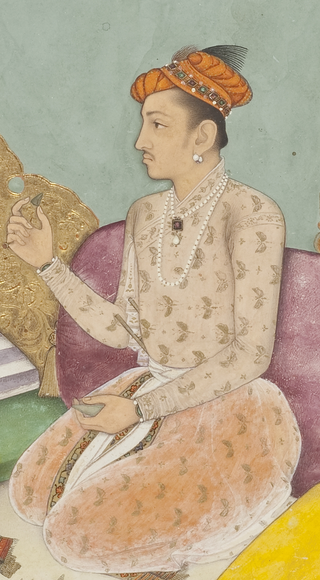
Mirza Raja Jai Singh I was the senior most general and a high ranking mansabdar at the imperial court of Mughal Empire as well as the Kachwaha ruler of the Kingdom of Amber. His predecessor was his grand uncle, Mirza Raja Bhau Singh, the younger son of Mirza Raja Man Singh I.

Samode Palace, Samode Haveli and Samode Bagh (Garden) are heritage monuments and structures built by the noble feudatory with the hereditary title of 'Maha Rawal' or 'Maha Saheb’ of the Amber and Jaipur principality in Rajasthan, India. All three have rich history of several hundred years and display a fusion of Mughal and Rajasthani art and architecture. They are now part of the Heritage group of hotels under the flagship name of "Samode" that are run by the hereditary owners of these structures. The Samode Palace is located 40 kilometres (25 mi) north of Jaipur city, the Samode Haveli is close to Jaipur (centrally located within city limits, 6 kilometres (3.7 mi) away from the city railway station) and the Samode Bagh or Garden, 4 kilometres (2.5 mi) from the palace which is also run as a luxury hotel.
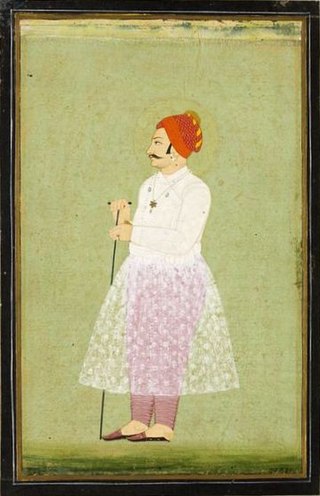
Mirza Raja Bishan Singh was the Kachwaha Rajput ruler of the Kingdom of Amer .He succeeded his grandfather Mirza Raja Ram Singh I since his father Kishan Singh died in the lifetime of his grandfather.He was also the subahdar of the province of Assam from the year 1687 to 1695 in the reigning times of Mughal Emperor Aurangzeb.He is known to have fathered one of the most eminent political icons of 18th century India i.e Sawai Jai Singh II.
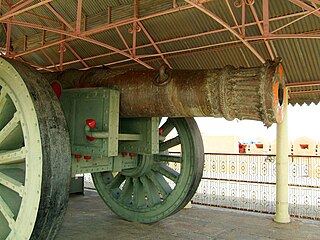
The Jaivana Cannon is a large 18th-century cannon preserved at Jaigarh Fort, in Rajasthan, India. At the time of its manufacture in 1720, it was the world's largest cannon on wheels of the Early Modern Era.

The City Palace, Jaipur is a royal residence and former administrative headquarters of the rulers of the Jaipur State in Jaipur, Rajasthan. Construction started soon after the establishment of the city of Jaipur under the reign of Maharaja Sawai Jai Singh II, who moved his court to Jaipur from Amber, in 1727. Jaipur remained the capital of the kingdom until 1949—when it became the capital of the present-day Indian state of Rajasthan—with the City Palace functioning as the ceremonial and administrative seat of the Maharaja of Jaipur. The construction of the Palace was completed in 1732 and it was also the location of religious and cultural events, as well as a patron of arts, commerce, and industry. It was constructed according to the rules of vastushastra, combining elements of Mughal and Rajput architectural styles. It now houses the Maharaja Sawai Man Singh II Museum, and continues to be the home of the Jaipur royal family. The royal family has around 500 personal servants. The palace complex has several buildings, various courtyards, galleries, restaurants, and offices of the Museum Trust.The MSMS II Museum Trust is headed by chairperson Rajamata Padmini Devi of Jaipur. Princess Diya Kumari runs the Museum Trust, as its secretary and trustee. She also manages The Palace School and Maharaja Sawai Bhawani Singh School in Jaipur. She founded and runs the Princess Diya Kumari Foundation to empower underprivileged and underemployed women of Rajasthan. She is also an entrepreneur. In 2013, she was elected as Member of the Legislative Assembly of Rajasthan from the constituency of Sawai Madhopur.

Garh Ganesh Temple is an 18th-century temple of Lord Ganesh in the city of Jaipur. It is located on the Aravali hills near Nahargarh Fort and Jaigarh Fort.
The Mughal–Rajput wars were a series of battles between the Rajput Confederacy and the Mughal Empire. The conflicts originated with the invasion of northwestern India by the Mughal ruler Babur, to which the head of the Rajput confederacy, Rana Sanga, offered staunch resistance.

Hill Forts of Rajasthan are six forts, spread across Rajasthan state in northern India. They have been clustered as a series and designated as a UNESCO World Heritage Site in 2013. The hill forts series include—Chittor Fort at Chittorgarh, Kumbhalgarh Fort at Rajsamand, Ranthambore Fort at Sawai Madhopur, Gagron Fort at Jhalawar, Amer Fort at Jaipur and Jaisalmer Fort at Jaisalmer.

Kanak Vrindavan is a garden in Jaipur, the capital of Rajasthan. It is built in a valley surrounded by Aravali hills and is located on the way to the Amer Fort at the bottom of the Nahargarh hill. The place is approx 8 km north of the Jaipur city. The garden has many nearby tourist attractions as the Amer fort Palace, Jaigarh fort and Nahargarh Fort along with much lush greenery.
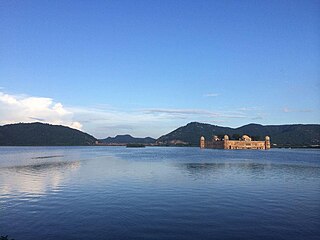
Man Sagar Lake is an artificial lake, situated in Jaipur, the capital city of the state of Rajasthan in India. It is named after Raja Man Singh, the then ruler of Amer, who constructed it in c. 1610 by damming the Dravyavati river. The Jal Mahal is situated in the middle of the lake.
Raja Prithviraj Singh I, also known as Prithvi Singh I, was the 16th-century Kachwaha Rajput ruler of Kingdom of Amber. He was a monarch of strong religious inclinations and during his reign, the Kingdom of Amber became increasingly politically active. He took part in the Rajput alliance against Mughal Emperor Babur, fighting against the latter in the Battle of Khanwa alongside Rana Sanga of Mewar in the year 1527. Three of Raja Prithviraj's sons successively followed him as ruler of Amber, with many of his descendants also populating the kingdom's highest aristocracy in subsequent centuries.

